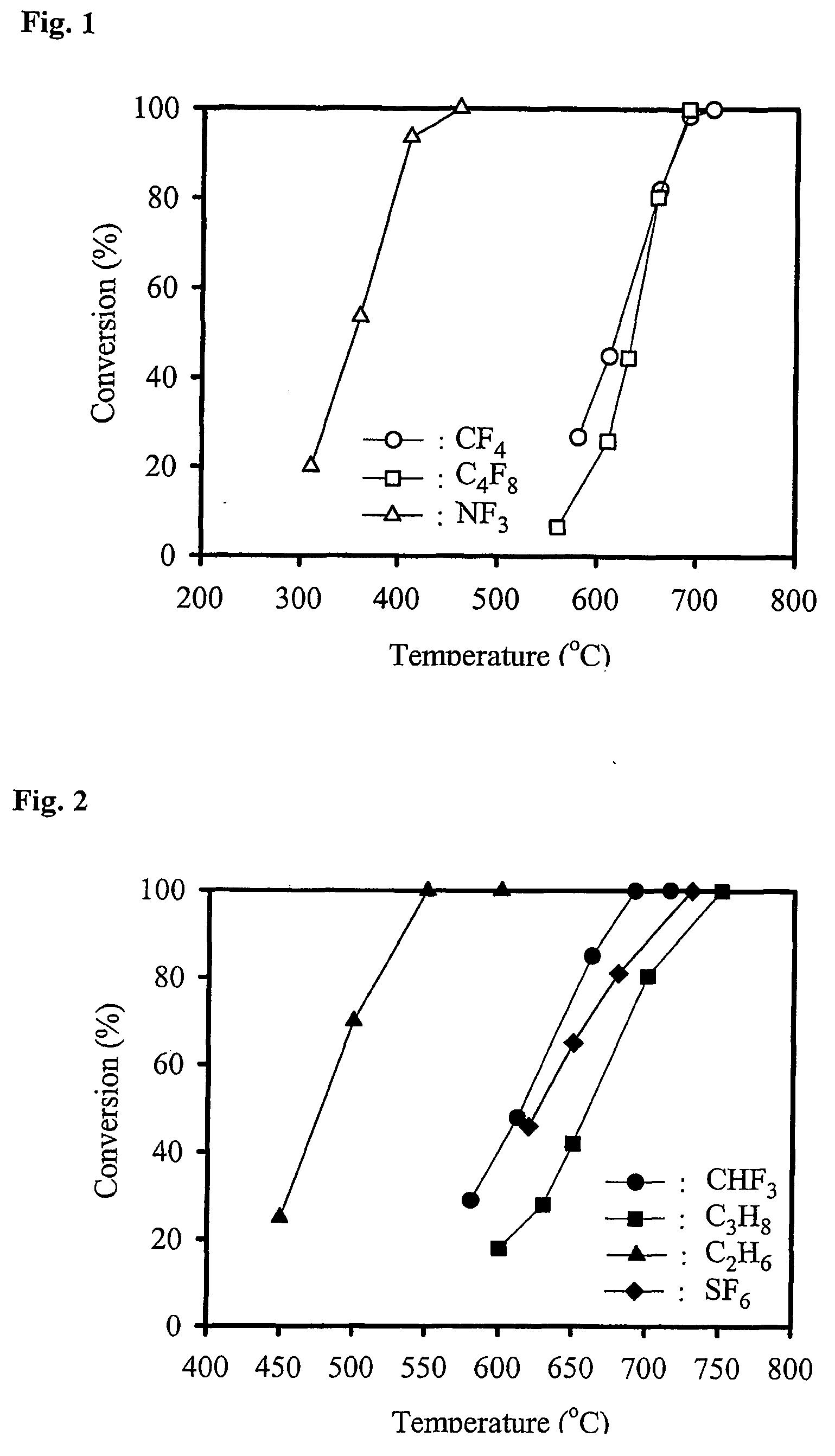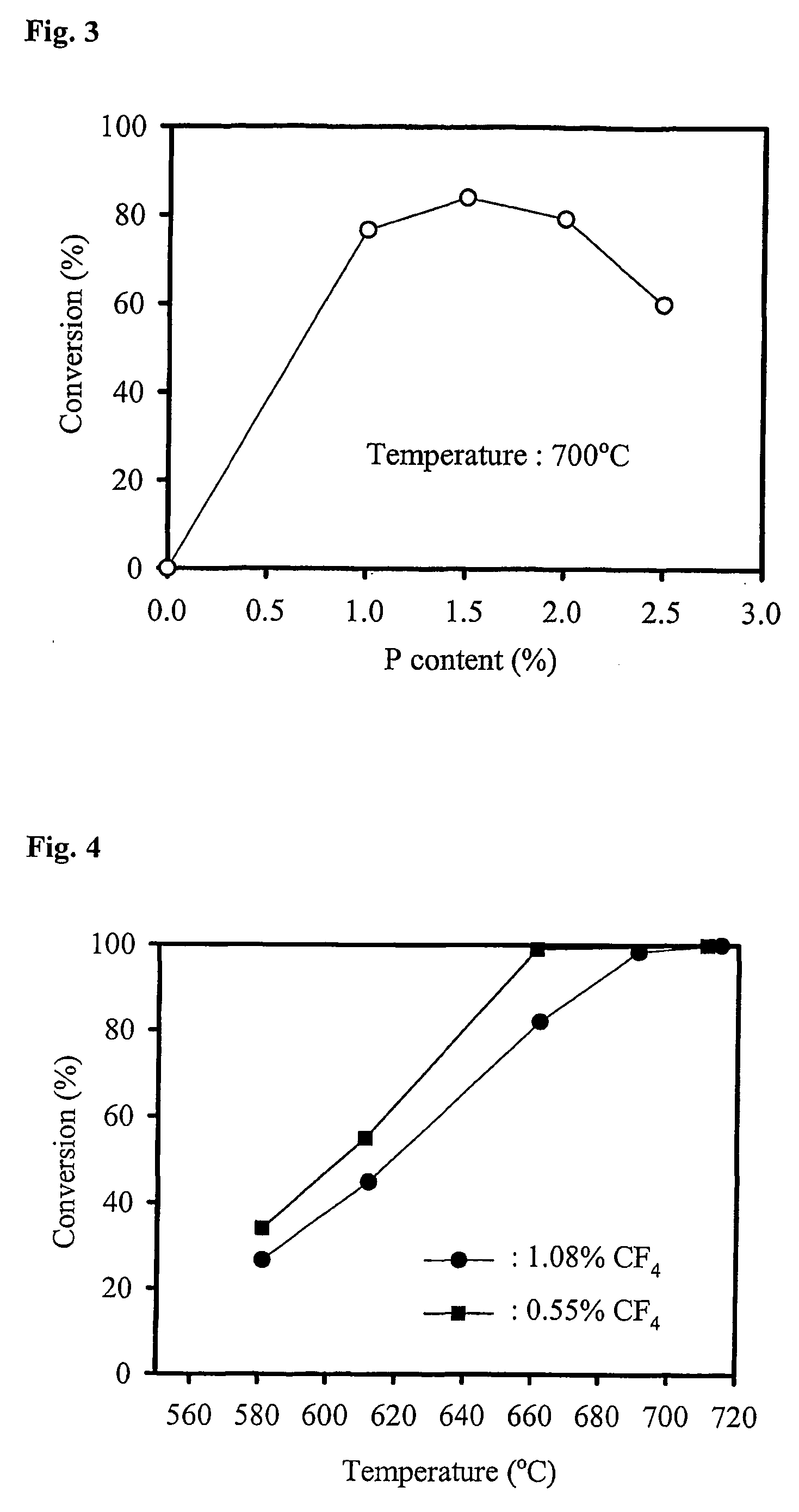Catalyst and method for decomposition of perfluoro-compound in waste gas
a technology of perfluorocompound and waste gas, which is applied in the direction of catalyst activation/preparation, physical/chemical process catalysts, and catalysts, etc., can solve the problems of limited commercial applications, insufficient durability of plasma generating systems, and severe corrosion of burning apparatuses, etc., to promote hydrolysis reaction, reduce decomposition rate, and high catalytic activity and durability
- Summary
- Abstract
- Description
- Claims
- Application Information
AI Technical Summary
Benefits of technology
Problems solved by technology
Method used
Image
Examples
example i
[0043] For the preparation of aluminum oxide catalyst loaded with 2.5 mole % (Al / P=39) of P, 0.2.7 g of (NH3)2HPO4 dissolved in 35 g of distilled water was impregnated on 40 g of aluminum oxide (Al2O3) powder and then followed by oven drying at 100° C. for 10 hrs and calcining in muffle furnace at 750° C. for 10 hrs.
[0044] 5 g of the obtained catalyst was charged into a ¾″ Inconel tube and then PFC decomposition reaction was carried out while flowing 1.01 ml / min CF4, 2.87 mL / min O2 and 89.4 ml / min He gases, which corresponds to 1.08 vol % of CF4 anda space velocity of 1,500 h−1 except water at room temperature. 0.04 ml / min of distilled water was introduced together with gas mixture using a syringe pump. The conversion of CF4 was calculated based on the following formula 1. As shown in FIG. 1, the CF4 was decomposed into to CO2 with 100% selectivity above 690° C.
CF4 Conversion=[1−(CF4 concentration at outlet of reactor / CF4 concentration at inlet of reactor)]×100 Formula 1
Selectiv...
example ii
[0045] NF3 decomposition reaction was carried out in the same reaction condition as in Example I after loading 5 g of the catalyst prepared in Example I. Instead of CF4, 1.01 ml / min NF3, 2.87 ml / min O2 and 89.4 ml / min He gases together with 0.04 ml / min distilled water were fed to the reactor. As shown in FIG. 1, 100% of NF3 was decomposed above 400° C. Elemental analysis of the catalyst was carried out after 10 hours reaction at 500° C. using an energy dispersion x-ray analyzer (EDAX). It was found that F component did not accumulate in the catalyst even after reaction.
example iii
[0046] C4F8 decomposition reaction was carried out in the same reaction condition as in Example II after loading 5 g of the catalyst prepared in Example I. Instead of NF3, 1.08 ml / min C4F8, 2.87 ml / min O2 and 89.4 ml / min He gases together with 0.04 ml / min distilled water were fed to the reactor. As a result, it was found that 100% of C4F8 was decomposed into CO2 above 690° C. (see FIG. 1).
PUM
| Property | Measurement | Unit |
|---|---|---|
| Temperature | aaaaa | aaaaa |
| Fraction | aaaaa | aaaaa |
| Concentration | aaaaa | aaaaa |
Abstract
Description
Claims
Application Information
 Login to View More
Login to View More - R&D
- Intellectual Property
- Life Sciences
- Materials
- Tech Scout
- Unparalleled Data Quality
- Higher Quality Content
- 60% Fewer Hallucinations
Browse by: Latest US Patents, China's latest patents, Technical Efficacy Thesaurus, Application Domain, Technology Topic, Popular Technical Reports.
© 2025 PatSnap. All rights reserved.Legal|Privacy policy|Modern Slavery Act Transparency Statement|Sitemap|About US| Contact US: help@patsnap.com



